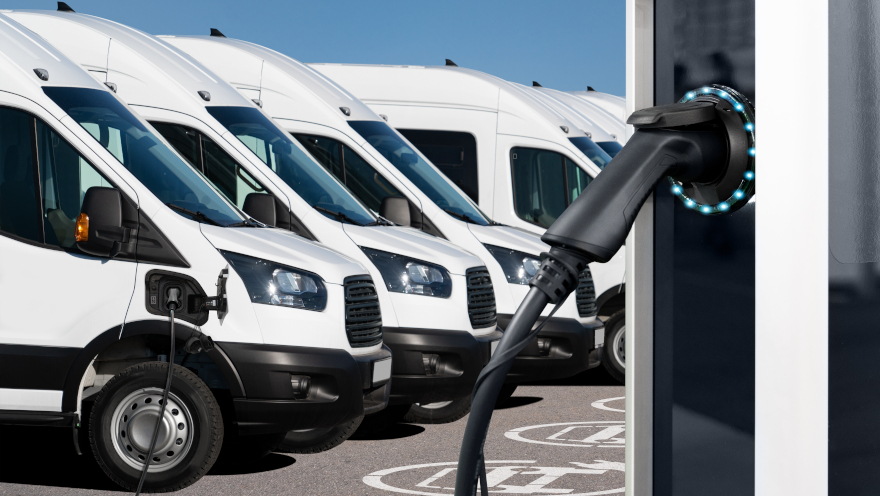COMMENTARY: 6 considerations for the commercial transition to a BEV fleet, other than infrastructure

The transition to battery electric vehicles is a conversation today in almost everyone’s social circle. And while the path for transition to a BEV is quite clear for personal use, the path to transition commercial fleets remains challenging.
And although the most common argument against BEVs for both personal and commercial use cases remains a lack of sufficient infrastructure, infrastructure is not the only consideration for fleet managers considering this transition.
Peak demand and duty cycles: The number of shifts per day, total miles per shift, availability for charging and the length of those downtimes are essential to whether or not a commercial fleet will be able to transition to BEVs successfully. Vehicles only in use for eight hours per day, for example as in final mile delivery, are a natural fit for a BEV fleet; less than 50 miles driven daily and opportune times for recharging such as during loading periods being the best overall fit.
Some use cases may require simple adjustments in duty cycles to ensure availability of charging, but BEVs may simply not work for industries that don’t have available downtime to charge or the downtime is rarely at a location with available charging access.
Use case: Fleets, such as non-emergency medical transport vehicles, vans with wholesale delivery routes, home services such as mobile vehicle maintenance or pet grooming, are the perfect use case for BEVs. However, commercial fleets that require heavy auxiliary equipment or require power take-off (PTO) units are not the best fit for BEV transition. Tow trucks that use a winch regularly or a carpet cleaning fleet that uses truck-mounted water extraction machines likely would find a BEV transition to be challenging due to the nature of their work and equipment requirements.
Geography: Aside from local infrastructure and regulation, organizations should also consider their locations’ geographies – and in particular weather patterns. BEVs require additional consideration because they can be impacted by extreme cold and extreme heat.
For example, our partners at Escalent note that extreme cold can significantly reduce range due to the energy needed to heat the cabin of a vehicle and lower battery efficiency at these temperatures, while extreme heat can speed up battery degradation. When encountering a battery issue in an ICE vehicle, the fix is relatively easy and inexpensive, however BEV battery replacements are much more time and capital intensive.
Dependability: While every business owner or fleet manager’s goals for their fleet is 100% uptime, that simply isn’t required for all business applications. In fact, mail couriers, garbage trucks, and delivery services can manage in the event they can’t provide services for a day or two.However, emergency fleets must be available 100% and ready to perform in the most extreme conditions.
Utility fleets are a great example – they are not only required to operate in the most extreme weather conditions, in the event of a power outage, it just wouldn’t work if their refueling mechanism was out of commission!
Fleet size: Larger companies and publicly traded companies are certainly more motivated to consider a transition to BEVs – whether for their public image or from shareholder pressure to diminish their carbon footprint. But these organizations with larger fleets and ‘green’ goals also have the additional luxury of experimentation and increased resources.
Under 5 to 10% of their fleet could provide a decent trial, and won’t create the risk of impact it would for a smaller organization.For a smaller fleet (62% of all fleets in the US are 5 or fewer vehicles) the transition to a new fuel drive train is not just the cost of the investment in the vehicle, it demands new organizational planning, new insurance, and new processes. It probably also warrants new marketing to take advantage of the investment in the community.
Availability: In the last few years, the automotive industry has experienced vehicle inventory at the lowest levels ever. Although tax credits for personal BEVs are currently being limited, as long as the manufacturer is qualified (click here for the current list of qualified manufacturers) and the BEVs are used for commercial purposes, that model is eligible for a tax credit (read more here).
And while demand for BEVs is smaller than for ICE vehicles in the commercial space today, OEMs are looking at ramping up production for BEVs for commercial use because overall commercial vehicle demand remains high.
So what should you do?
First, review the checklist: consider your geography, availability of charging infrastructure, use case and consider if you can afford for your fleet — or portions of your fleet — to be out of commission for periods of time either to charge or due to lack of charging availability in the event of an electrical outage.
If a BEV transition still makes sense for your organization, then consider renting or lease options that would allow for a cost-effective way for your organization to test how a BEV transition may positively or negatively impact your business and processes.
You can compare the cost effectiveness of a BEV transition for your fleet, especially if you have to consider public charging costs during peak load times, and can also plan any necessary adjustments to optimize duty cycles for when and how your fleet will charge.
Finally, talk with dealers and upfitters to understand your options and the availability of those options, as well as the best ways to upfit those particular vehicles. While the exterior of the vehicle often looks identical to an ICE vehicle, BEVs are structurally different and offer different opportunities to structure an upfit for your particular needs. A BEV transition may be beneficial for your commercial fleet, but understanding the considerations beyond infrastructure is essential to a successful transition. Sign up for the bi-weekly email newsletter on Comvoy.com and use their growing resource center for EV/alt-fuel education.


